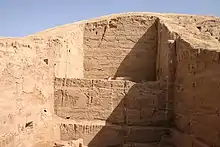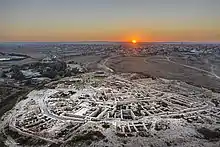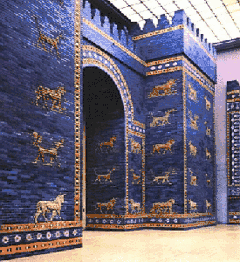
In archaeology a tell or tel (borrowed into English from Arabic: تَلّ, tall, 'mound' or 'small hill')[1] is an artificial topographical feature, a mound consisting of the accumulated and stratified debris of a succession of consecutive settlements at the same site, the refuse of generations of people who built and inhabited them and natural sediment.[2][3][4][5]
Tells are most commonly associated with the ancient Near East but they are also found elsewhere, such as Southern and parts of Central Europe, from Greece and Bulgaria to Hungary and Spain[6][7] and in North Africa.[3][8][9][10] Within the Near East they are concentrated in less arid regions, including Upper Mesopotamia, the Southern Levant, Anatolia and Iran, which had more continuous settlement.[11] Eurasian tells date to the Neolithic,[12] the Chalcolithic and the Bronze and Iron Ages.[13] In the Southern Levant the time of the tells ended with the conquest by Alexander the Great, which ushered in the Hellenistic period with its own, different settlement-building patterns. Many tells across the Near East continue to be occupied and used today.[14]
Etymology
The word tell is first attested in English in an 1840 report in the Journal of the Royal Geographical Society.[15] It is derived from the Arabic تَلّ (tall) meaning 'mound' or 'hillock'.[1][15] Variant spellings include tall, tel, til and tal.[16]
The Arabic word has many cognates in other Semitic languages, such as Akkadian tīlu(m), Ugaritic tl[17] and Hebrew tel (תל).[18] The Akkadian form is similar to Sumerian DUL, which can also refer to a pile of any material, such as grain, but it is not known whether the similarity reflects a borrowing from that language or if the Sumerian term itself was a loanword from an earlier Semitic substrate language.[19] If Akkadian tīlu is related to another word in that language, til'u, meaning 'woman's breast', there exists a similar term in the South Semitic classical Ethiopian language of Geʽez, namely təla, 'breast'.[17] Hebrew tel first appears in the biblical book of Deuteronomy 13:16 (ca 500–700 BCE),[20] describing a heap or small mound and appearing in the books of Joshua, and Jeremiah with the same meaning.


There are lexically unrelated equivalents for this geophysical concept of a town-mound in other Southwest Asian languages, including kom in Egyptian Arabic,[21] tepe or tappeh (Turkish/Persian: تپه), hüyük or höyük (Turkish) and chogha (Persian: چغا, from Turkish çokmak and derivatives çoka etc.).[22] These often appear in place names,[16] and the word itself is one of the most common prefixes for Palestinian toponyms.[23] The Arabic word khirbet, also spelled khirbat (خربة), meaning 'ruin', also occurs in the names of many archaeological tells, such as Khirbet et-Tell (roughly meaning 'heap of ruins').[24]
Formation
A tell can only be formed if natural and man-produced material accumulates faster than it is removed by erosion and human-caused truncation,[5] which explains the limited geographical area they occur in.
Tells are formed from a variety of remains, including organic and cultural refuse, collapsed mudbricks and other building materials, water-laid sediments, residues of biogenic and geochemical processes and aeolian sediment.[25] A classic tell looks like a low, truncated cone with sloping sides[26] and a flat, mesa-like top.[27] They can be more than 43 m (141 ft) high.[22]
Occurrence
Southwest Asia

It is thought that the earliest examples of tells are to be found in the Jordan Valley, such as at the 10-meter-high mound, dating back to the proto-Neolithic period, at Jericho in the West Bank.[3] Upwards of 5,000 tells have been detected in the area of ancient Israel and Jordan.[28] Of these Paul Lapp calculated in the 1960s that 98% had yet to be touched by archaeologists.[28]
In Syria tells are abundant in the Upper Mesopotamia region, scattered along the Euphrates, including Tell al-'Abr, Tell Bazi, Tell Kabir, Tell Mresh, Tell Saghir and Tell Banat.[29] The last is thought to be the site of the oldest war memorial (known as the White Monument), dating from the 3rd millennium BCE.[30]
Europe
Tells can be found in Europe in countries such as Spain, Hungary, Romania,[7] Bulgaria,[31] North Macedonia and Greece.[7]
Northeastern Bulgaria has a rich archaeological heritage of eneolithic (4900–3800 BCE[32]) tells from the 5th millennium BCE.[31]
In Neolithic Greece there is a contrast between the northern Thessalian plain where rainfall was sufficient to permit densely populated settlements based on dry-farming and the more dispersed sites in southern Greece, such as the Peloponesus, where early villages sprang up around the smaller arable tracts close to springs, lakes and marshes.[33] There are two models to account for the tell structures of this part of southern Europe, one developed by Paul Halstead and the other by John Chapman. Chapman envisaged the tell as witness to a nucleated communal society, whereas Halstead emphasized the idea that they arose as individual household structures.[34] Thessalian tells often reflect small hamlets with a small population of around 40–80.[35]
The Toumbas of Macedonia and the Magoulas of Thessaly are the local names for tell sites in these regions of Greece.
See also
References
Citations
- 1 2 Kirkpatrick, E. M., ed. (1983). Chambers 20th Century Dictionary (New ed.). Edinburgh: W & R Chambers Ltd. p. 1330. ISBN 0550102345.
- ↑ Orengo&al 2020, p. 18240.
- 1 2 3 Shaw 2002, p. 566.
- ↑ Negev, Avraham; Gibson, Shimon, eds. (2001). "Tell". Archaeological Encyclopedia of the Holy Land. New York and London: Continuum. p. 497. ISBN 0-8264-1316-1. Retrieved 9 October 2021.
- 1 2 Matthews (2020), Introduction and Definition
- ↑ Bailey&al 1998, p. 373-396.
- 1 2 3 Blanco-González & Kienlin 2020, ch. 1, see map.
- ↑ MacDonald 1997, pp. 40–42.
- ↑ Davidson&al 2010, pp. 1564–1571.
- ↑ Kotsakis 1999, p. 66.
- ↑ Wilkinson 2003, pp. 100–127.
- ↑ Blanco-González & Kienlin 2020, ch. 1.
- ↑ Chapman, John. In Blanco-González & Kienlin 2020, ch. 14.
- ↑ "TerraWatchers, UCSD, and ASOR CHI Partner to Monitor Archaeological Sites". American Society of Overseas Research (ASOR). 17 January 2019. Retrieved 2021-10-13.
- 1 2 "tell". Oxford English Dictionary (Online ed.). Oxford University Press. (Subscription or participating institution membership required.)
- 1 2 Hirst 2019.
- 1 2 Leslau 1958, p. 55.
- ↑ tel in Strong's Concordance via biblehub.com
- ↑ Suriano 2012, p. 214, notes 17-19.
- ↑ Bos, James M. (2013). Reconsidering the Date and Provenance of the Book of Hosea. Bloomsbury. ISBN 978-0-567-06889-7.
- ↑ Shaw 2002, p. 567.
- 1 2 Matthews 2020, p. 7260.
- ↑ Warfield 1885, p. 274.
- ↑ Wagemakers 2014, p. 40.
- ↑ Wilkinson 2003, p. 108.
- ↑ Albright 1949, p. 16.
- ↑ Suriano 2012, p. 213.
- 1 2 Lapp 1975, p. 1.
- ↑ Anne Porter (2018). "The Tell Banat Settlement Complex during the Third and Second Millennia BCE" (PDF). Vorderasiatische Archäologie.
- ↑ Anne Porter; et al. (2021). ""Their corpses will reach the base of heaven": a third-millennium BCE war memorial in northern Mesopotamia?". Cambridge University Press. pp. 1–19. doi:10.15184/aqy.2021.58.
- 1 2 Bailey&al 1998, p. 378.
- ↑ Bailey&al 1998, p. 375).
- ↑ Bintliff 2012, p. 53.
- ↑ Bintliff 2012, pp. 53–54.
- ↑ Bintliff 2012, p. 55.
Works cited
- Albright, William Foxwell (1949). The Archaeology of Palestine. Penguin Books. pp. 7–22.
- Bailey, Douglass; Tringham, Ruth; Bass, Jason; Stevanović, Mirjana; Hamilton, Mike; Neumann, Heike; Angelova, Ilke; Raduncheva, Ana (Winter 1998). "Expanding the Dimensions of Early Agricultural Tells: The Podgoritsa Archaeological Project, Bulgaria". Journal of Field Archaeology. 25 (4): 373–396. JSTOR 530635.
- Bintliff, John (2012). The Complete Archaeology of Greece: From Hunter-Gatherers to the 20th Century A.D. John Wiley & Sons. ISBN 978-1-118-25520-9.
- Blanco-González, Antonio; Kienlin, Tobias L., eds. (2020). Current Approaches to Tells in the Prehistoric Old World: A cross-cultural comparison from Early Neolithic to the Iron Age. Oxbow Books. ISBN 9781789254877. Retrieved 9 October 2021.
- Chapman, John (2000). Fragmentation in Archaeology: People, Places, and Broken Objects in the Prehistory of South-eastern Europe. Psychology Press. ISBN 978-0-415-15803-9.
- Davidson, Donald A.; Wilson, Clare A.; Lemos, Irene S.; Theocharopoulos, S. P. (2010-07-01). "Tell formation processes as indicated from geoarchaeological and geochemical investigations at Xeropolis, Euboea, Greece". Journal of Archaeological Science. 37 (7): 1564–1571. Bibcode:2010JArSc..37.1564D. doi:10.1016/j.jas.2010.01.017. hdl:1893/16434.
- Hirst, K. Kris (22 March 2019). "What Is a Tell? The Remnants of Ancient Mesopotamian Cities". ThoughtCo.
- Kotsakis, Kostas (1999). "What Tells can Tell: Social Space and Settlement in the Greek Neolithic". In Halstead, Paul (ed.). Neolithic Society in Greece. Sheffield Academic Press. ISBN 978-1-850-75824-2.
- Lapp, Paul W. (1975). Lapp, Nancy L.; Hadidian, Fikran (eds.). The Tale of the Tell: Archaeological Studies by Paul W. Lapp. Wipf and Stock Publishers. ISBN 978-1-725-24234-0.
- Leslau, Wolf (1958). Ethiopic and South Arabic Contributions to the Hebrew Lexicon. Vol. XX. University of California Publicans in Semitic Philology.
- MacDonald, Kevin C. (23 November 1997). "More forgotten tells of Mali: an archaeologist's journey from here to Timbuktu" (PDF). Archaeology International. 1 (1): 40–42. doi:10.5334/ai.v1i0.216.
- Matthews, Wendy (2020). "Tells in Archaeology". In Smith, Claire (ed.). Encyclopedia of Global Archaeology. Springer. pp. 7259–7262. doi:10.1007/978-3-030-30018-0_1512. ISBN 978-3-030-30016-6. S2CID 241215415.
- Orengo, Hector A.; Conesa, Francesc C.; Garcia-Molsosa, Arnau; Lobo, Agustín; Green, Adam S.; Madella, Marco; Petrie, Cameron A. (4 August 2020). "Automated detection of archaeological mounds using machine-learning classification of multisensor and multitemporal satellite data" (PDF). PNAS. 117 (31): 18240–18250. Bibcode:2020PNAS..11718240O. doi:10.1073/pnas.2005583117. PMC 7414161. PMID 32690717.
- Shaw, Ian (2002). "Tell". In Shaw, Ian; Jameson, Robert (eds.). A Dictionary of Archaeology. John Wiley & Sons. pp. 566–567. ISBN 978-0-631-23583-5.
- Suriano, Matthew J. (2012). "Ruin Hills at the Threshold of the Netherworld: The Tell in the Conceptual Landscape of the Ba'al Cycle and Ancient Near Eastern Mythology". Die Welt des Orients. 42 (2): 210–230. doi:10.13109/wdor.2012.42.2.210. JSTOR 23342127.
- Wagemakers, Bart (2014). "Khirbet Et-Tell (Ai?)". Archaeology in the 'Land of Tells and Ruins': A History of Excavations in the Holy Land Inspired by the Photographs and Accounts of Leo Boer. Oxbow Books. ISBN 978-1-782-97245-7.
- Warfield, Benjamin (1885). "The Scenes of the Baptist's Work". In Nicoll, W. Robertson (ed.). The Expositor. Hodder and Stoughton. pp. 267–282.
- Wilkinson, Toby J. (2003). Archaeological Landscapes of the Near East. University of Arizona Press. pp. 100–127. ISBN 978-0-816-52173-9.
Further reading
- Lloyd, Seton (1963). Mounds of the Near East. Edinburgh University Press.
- Small, David B. (2019). The Ancient Greeks: Social Structure and Evolution. Cambridge University Press. ISBN 978-0-521-89505-7.
External links
 Media related to Tell (archaeology) at Wikimedia Commons
Media related to Tell (archaeology) at Wikimedia Commons

